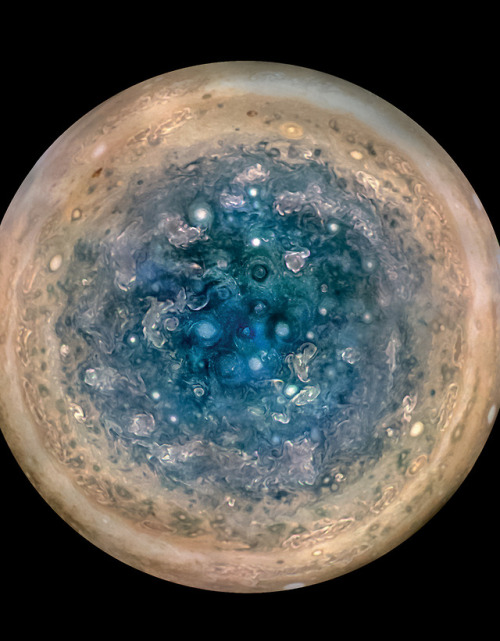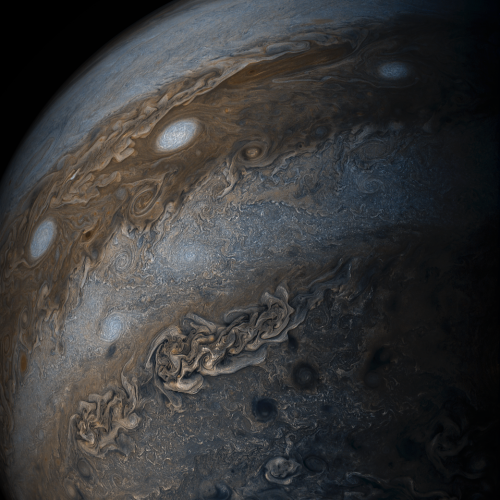The Jovian System

the Jovian System
More Posts from Jovian-witch and Others
cosmic witchcraft 101: jovian magick ♃
Jupiter is the fifth planet from the Sun. Due to its massive size, there are multiple ways the planet could have formed. Regardless of its formation process, some scientists believe that Jupiter migrated inward right up to the orbit of Mars after its initial formation. This is referred to as the Grand Tack Hypothesis. In the early solar system, Neptune and the other outer planets may have begun interacting with icy planetesimals, sending comets from one planet to the next, causing Uranus, Neptune, and Saturn to move outwards as the comets moved inwards. When the comets reached Jupiter, the planet’s massive gravity flung the comets into highly elliptical orbits or out of the solar system entirely and Jupiter migrated inwards to conserve angular momentum.
As it made its way towards the Sun, Jupiter’s gravity would have prevented the asteroid belt material from forming into planets and swept away large amounts of material that may have made Mars more massive. Thanks to Saturn, Jupiter stopped its inward migration and turned around, settling approximately where we see it today. As Jupiter moved inward and Saturn moved outward, it’s theorized that they became locked in a 3:2 orbital resonance, with Saturn finishing 3 orbits around the Sun for Jupiter’s 2. Jupiter’s migration may have also brought icy and gaseous material into the inner solar system, helping the inner planets form their atmospheres and perhaps even providing those vital life-giving compounds we can thank for our existence today.
Facts:
Jupiter produces more heat than it receives from the Sun.
Jupiter is more than twice as massive as all the other planets combined.
The planet has at least 67 moons.
Jupiter is NOT a failed star. The smallest stars in the observable universe have about 1/12 of the Sun’s mass, and Jupiter has about 1/1000th of the Sun’s mass. Jupiter is simply a colossal planet.
The Great Red Spot is larger than Earth. It’s a colossal hurricane that’s been going on since the 17th century, maybe even before that.
Jupiter rotates faster than any of the other planets; a Jovian day is only about 10 Earth hours. It takes 11.86 years to orbit around the Sun.
Lighter stripes along the planet are called zones and darker stripes are called belts. They flow in opposite directions and turbulence between regions causes the Jupiter’s storms.
Magickal Correspondences*
Colors: red, white, yellow, brown, purple
Intents: growth, expansion, prosperity, justice, exploration, freedom, protection, spiritual evolution, success, meditation, psychic development, confidence, storm magick
Herbs: frankincense, rosemary, oak, cedar, nutmeg, sage, anise, catnip, sandalwood, rosehips, dandelion, fennel, tansy
Crystals: tin, amethyst, lepidolite, sugilite, lapis lazuli, sapphire, diamond, agate, antimony, rhodocrosite, aragonite, jasper, onyx, amber
*some of these correspondences are based on traditional associations and some are based on my personal associations

Jupiter in infrared, Shoemaker–Levy 9 collision (left), Io (right)
Comet Shoemaker–Levy 9 was a comet that broke apart in July 1992 and collided with Jupiter in July 1994, providing the first direct observation of an extraterrestrial collision of Solar System objects. This generated a large amount of coverage in the popular media, and the comet was closely observed by astronomers worldwide. The collision provided new information about Jupiter and highlighted its possible role in reducing space debris in the inner Solar System.
source
I want to share this jupiter setup for wealth/success I’m using because it’s extremely simple to do and has been really good these last weeks I’ve been working it -
Pentacles: Jupiter 2, 4, and 7, consecrated in the usual way
Oil: olive oil, gold leaf, cinnamon stick, honey, ashes of psalms 23 + 112, mix it all up and consecrate it to Sachiel in the hour of jupiter. full DSIC setup optional, a short prayer worked fine for me
You can add more jupiter-oriented or money-drawing stuff like orange peel or mint if you have it in your cabinet, I just used what I had. I recommend wheat honey if you can get it or some kind of wheat germ/wheat grain in there because I’ve had great success using it for prosperity stuff in the past.
Candle: any color as long as it’s blue
Just dress the candle with the oil (I poked 4 holes to drip the oil into since jupiter = 4) and burn it on top of the pentacles with a petition also underneath - day/hour of jupiter obviously - and ur good. It’s important to have a petition to focus it because without one, I got just random valuable shit showing up that wasn’t directly helpful financially. I hope this helps someone else because it’s the best simplicity to effectiveness ratio of anything I’ve come up with lately.

This image shows an enhanced colour, daytime and stereographic image of Jupiter’s south pole.
It was imaged by NASA’s Juno spacecraft from an altitude of 32,000 miles (52,000 kilometers). The oval features are cyclones, up to 600 miles (1,000 kilometers) in diameter.
![Voyager 1 Approaching Jupiter In 1979. [Reddit/spacegifs]](https://64.media.tumblr.com/57003d3715c75582218ee1b20aeb6a70/tumblr_p21webfuy81s04h2ho1_400.gif)
Voyager 1 approaching Jupiter in 1979. [Reddit/spacegifs]

Spell Circle
Purpose: To sanctify and maintain a space
Recommended Casting Type: Altar
Recommended Anchor: Wood
Outer Ring Translation: “Sanctify this space. Only my circle of spirits and gods may enter.”
Language: English
Script: Woevian
Planetary Correspondences: Sun/Jupiter/Saturn
Directional Correspondences: Center
Color Correspondences: Silver
Numerology: 0/1/3






jupiter.
Jupiter Success Spell ♃

*Best performed outdoors*
Required Items:
Representation of Jupiter (a picture or drawing will do)
Jupiter herbs (I used nutmeg and sage)
A pinch of Stardust Powder
Google SkyMaps [Android] or SkyView [Apple]
Instructions:
Using the SkyMaps app or something similar, locate Jupiter in the sky - channel energy from the planet to aid you in your spell
Add the Stardust Powder and herbs to a fire safe container
While focusing on the intent of gaining success and fortune, set the mixture ablaze
Let the fire burn out as your intent is released into the air

Swirling bands of light and dark clouds on Jupiter are seen in this image made by citizen scientists using data from our Juno spacecraft. Each of the alternating light and dark atmospheric bands in this image is wider than Earth, and each rages around Jupiter at hundreds of miles (km) per hour. The lighter areas are regions where gas is rising, and the darker bands are regions where gas is sinking. This image was acquired on May 19, 2017 from about 20,800 miles (33,400km) above Jupiter’s cloud tops. Learn more
Credits: NASA/JPL-Caltech/SwRI/MSSS/Gerald Eichstädt /Seán Doran
Make sure to follow us on Tumblr for your regular dose of space: http://nasa.tumblr.com


Planetary Witches / Jupiter Aesthetic
Visit my shop
-
 mothgirl-consortium reblogged this · 4 weeks ago
mothgirl-consortium reblogged this · 4 weeks ago -
 magicaltragedy-not liked this · 4 months ago
magicaltragedy-not liked this · 4 months ago -
 notamushimaster liked this · 5 months ago
notamushimaster liked this · 5 months ago -
 un-volumen-cristalino liked this · 1 year ago
un-volumen-cristalino liked this · 1 year ago -
 gotchipoints reblogged this · 2 years ago
gotchipoints reblogged this · 2 years ago -
 galaxyhazbin reblogged this · 2 years ago
galaxyhazbin reblogged this · 2 years ago -
 galaxyhazbin liked this · 2 years ago
galaxyhazbin liked this · 2 years ago -
 ghost-of-dunwich liked this · 2 years ago
ghost-of-dunwich liked this · 2 years ago -
 rufusahhahh liked this · 2 years ago
rufusahhahh liked this · 2 years ago -
 thishorriblemachine liked this · 2 years ago
thishorriblemachine liked this · 2 years ago -
 ferretfam reblogged this · 3 years ago
ferretfam reblogged this · 3 years ago -
 veeshadirus reblogged this · 3 years ago
veeshadirus reblogged this · 3 years ago -
 m3nyas liked this · 3 years ago
m3nyas liked this · 3 years ago -
 fossil-record liked this · 3 years ago
fossil-record liked this · 3 years ago -
 lunar-royalty liked this · 3 years ago
lunar-royalty liked this · 3 years ago -
 romycupcake0 liked this · 3 years ago
romycupcake0 liked this · 3 years ago -
 999deadblog999 liked this · 3 years ago
999deadblog999 liked this · 3 years ago -
 renega2-culturales liked this · 3 years ago
renega2-culturales liked this · 3 years ago -
 jovian-witch reblogged this · 3 years ago
jovian-witch reblogged this · 3 years ago -
 a-exists liked this · 3 years ago
a-exists liked this · 3 years ago -
 kostassus liked this · 3 years ago
kostassus liked this · 3 years ago -
 legenspeople reblogged this · 3 years ago
legenspeople reblogged this · 3 years ago -
 bloodporne reblogged this · 3 years ago
bloodporne reblogged this · 3 years ago -
 scourgebunny reblogged this · 3 years ago
scourgebunny reblogged this · 3 years ago -
 thisladyisawesome reblogged this · 3 years ago
thisladyisawesome reblogged this · 3 years ago -
 downwarddeathstare reblogged this · 3 years ago
downwarddeathstare reblogged this · 3 years ago -
 downwarddeathstare liked this · 3 years ago
downwarddeathstare liked this · 3 years ago -
 franqeinstein reblogged this · 3 years ago
franqeinstein reblogged this · 3 years ago -
 franqeinstein liked this · 3 years ago
franqeinstein liked this · 3 years ago -
 quontology liked this · 3 years ago
quontology liked this · 3 years ago -
 blackwarrior007 liked this · 3 years ago
blackwarrior007 liked this · 3 years ago -
 alvamsystem liked this · 3 years ago
alvamsystem liked this · 3 years ago -
 oursrosie reblogged this · 3 years ago
oursrosie reblogged this · 3 years ago -
 oursrosie liked this · 3 years ago
oursrosie liked this · 3 years ago -
 oflgtfol liked this · 3 years ago
oflgtfol liked this · 3 years ago -
 oflgtfol reblogged this · 3 years ago
oflgtfol reblogged this · 3 years ago -
 yunomonoko liked this · 3 years ago
yunomonoko liked this · 3 years ago -
 scawch liked this · 3 years ago
scawch liked this · 3 years ago -
 jindrone liked this · 3 years ago
jindrone liked this · 3 years ago -
 bravo-benji reblogged this · 3 years ago
bravo-benji reblogged this · 3 years ago -
 caracali liked this · 3 years ago
caracali liked this · 3 years ago -
 dryadfairy liked this · 3 years ago
dryadfairy liked this · 3 years ago -
 technicolorrelays liked this · 3 years ago
technicolorrelays liked this · 3 years ago -
 vaguecaninething reblogged this · 3 years ago
vaguecaninething reblogged this · 3 years ago -
 woollybearsaint liked this · 3 years ago
woollybearsaint liked this · 3 years ago -
 elemfant liked this · 3 years ago
elemfant liked this · 3 years ago -
 drowning-my-hurt-in-the-stars reblogged this · 3 years ago
drowning-my-hurt-in-the-stars reblogged this · 3 years ago

blog dedicated to my work with the planet Jupiter
96 posts